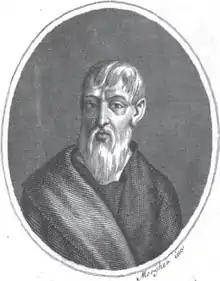Herodicus
Herodicus (Greek: Ἡρóδιĸος) was a Greek[1][2][3][4][5][6] physician of the 5th century BC, a native of Selymbria. The first use of therapeutic exercise for the treatment of disease and maintenance of health is credited to him, and he is believed to have been one of the tutors of Hippocrates. He also recommended good diet and massage using beneficial herbs and oils, and his theories are considered the foundation of sports medicine. He was specific in the manner that a massage should be given. He recommended that rubbing be initially slow and gentle, then subsequently faster, with the application of more pressure, which was to be followed by more gentle friction.[7]

Herodicus is also described as a gymnastic-master (παιδοτρίβης) and a sophist. According to Plato, Herodicus recommended that his patients walk from Athens to Megara, a distance of a little more than 20 miles.
References
- Janet Buckworth; Rod K. Dishman; Patrick J. O'Connor; Phillip D. Tomporowski (2013). Exercise Psychology. Human Kinetics. p. 3. ISBN 978-1-4504-0709-0.
- William D. McArdle; Frank I. Katch; Victor L. Katch (2006). Essentials of Exercise Physiology. Lippincott Williams & Wilkins. p. 7. ISBN 978-0-7817-4991-6.
- Jack W. Berryman (1 January 1992). Sport and Exercise Science: Essays in the History of Sports Medicine. University of Illinois Press. p. 12. ISBN 978-0-252-06242-1.
- Areej Hassan (6 March 2015). School Nutrition and Activity: Impacts on Well-Being. Apple Academic Press. p. 23. ISBN 978-1-4987-2173-8.
- Lawrence Barnet Phillips (1871). The Dictionary of Biographical Reference Containing One Hundred Thousand Names Together with a Classed Index of the Biographical Literature of Europe and America by Lawrence B. Phillips. Sampson Low, Son & Marston. p. 494.
- Physical Activity and Health: A Report of the Surgeon General. Government Printing Office. 1996. p. 13. GGKEY:4N1Z4L1RBBR.
- Early American Manual Therapy (Version 5.0) - Chapter 1 History and Development of Mechanical Vibration Therapy Archived 2005-03-09 at the Wayback Machine, Accessed: October 6, 2008. "IN THE 5TH CENTURY HERODICUS advocated exercise for the treatment of disease and compelled his patients to have their bodies rubbed, he being a firm believer in the efficacy of massage. JOSEPH SCHREIBER, M. D., author of "Treatment of Massage and Exercise," translated by Walter Mendelson, M. D., of New York, claims that Herodicus first laid down principles for rational, mechanical methods of treatment. HERODICUS, 484 B. C., was one of the first to refer to the manner of giving massage. He said friction should be gentle and slow at first, then rapid in combination with pressure, which was to be followed by gentle friction. Other advocates were Plato, Socrates, and Hippocrates, who said "rubbing can bind a joint that is too loose, and loosen a joint that is too rigid. Hard rubbing binds, soft rubbing loosens, much rubbing causes parts to waste, moderate rubbing makes them grow." This is the earliest definite information relative to the effect of variations in the application of massage. These maxims should be remembered by those who use mechanical vibration for they well define its general therapeutic application. Hipppocrates also suggested the direction in which to apply massage the art of rubbing up, thereby assisting mechanical and physical processes, aiding circulation, relieving stasis and consequently quickening metabolic processes."
